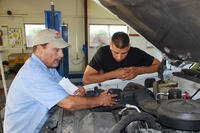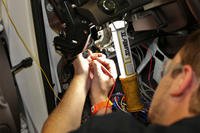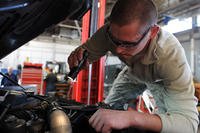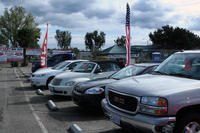by Rahul Kapoor
Carroll Shelby’s personal Boss 429 became a 1,000-hp missile that went to war. The Super Boss 429 was Ford’s wildest Mustang, rebuilt by Kar Kraft and flown to Vietnam to teach U.S. troops how to handle Detroit muscle. Tuned on nitromethane and packing a magnesium 6-71 blower, the "Super Boss" tore up airbase runways in front of 240,000 servicemen. This was no PR stunt; it was horsepower diplomacy, a rolling symbol of American grit.
Today, the same car sits in Bill Goldberg’s garage, a perfectly preserved time capsule of when Shelby, Ford, and fate collided at full throttle.
How The Super Boss 429 Became The Lawman

When Ford teamed up with drag racer and attorney Al “Lawman” Eckstrand in 1970, the goal wasn’t to sell Mustangs. It was to keep American troops connected to home. The Vietnam War was raging, and Ford’s executives wanted to do something bold for morale, something that blended Detroit iron with a sense of purpose. That’s how the Super Boss 429 program came alive.
The Lawman Performance Team rolled out seven cars: five 428 Cobra Jets, one Super Boss 429, and a Ford station wagon packed with tools and spares. These weren’t props. They were hand-built by Kar Kraft, Ford’s experimental arm in Brighton, Michigan, the same crew responsible for the GT40. The mission was simple but powerful: teach returning soldiers how to control high-horsepower muscle cars safely, while giving them an unforgettable show.

The program hit bases in Japan, Okinawa, Vietnam, and Hawaii. Crowds of thousands watched the Lawman team shred airbase runways, with the Super Boss’ blown V8 echoing off hangars. That is when disaster struck. In Vietnam, one of the original Super Boss 429s was crushed under a shipping container full of paper rolls. The loss was devastating, and the show had only days before its next scheduled performance.

That’s when Carroll Shelby stepped in. He had a Boss 429 set aside for himself, VIN 0F02Z110429. Without hesitation, he told Ford and Eckstrand to use his car for the replacement build. According to Dennis Collins, Ford and Kar Kraft pulled off the impossible: within 48 hours, Shelby’s personal Boss was stripped, reassembled, and on a U.S. Air Force C-130 headed to Asia. When the Super Boss 429 arrived, it was no longer Shelby’s personal car, it became The Lawman, a Mustang forged in war.
From Shelby’s Garage To 1,000 HP, This Rebuild Shocked Detroit

The replacement for the wrecked Super Boss 429 was built under the kind of pressure that would break most factory teams. Ford called in Kar Kraft, Connie Kalitta, and Roy Steffey, a trio of drag-racing heavyweights. Working through the night, they stripped Shelby’s car to bare metal, loaded it with race-grade parts, and turned it into a 1,000-hp warhorse in less than two days.
Under the hood sat the legendary 429-cubic-inch “semi-hemi” NASCAR motor. With forged internals and free-flowing aluminum heads, the Shelby Boss 429 already had serious pedigree. But this version was far from stock. A magnesium 6-71 blower cranked boost into the cylinders, while a nitromethane setup turned it from a muscle car into a missile. Power shot past 1,200 hp, and torque climbed above 900 lb-ft. Even more radical, the car ran a reverse-pattern automatic, making it the only Boss 429 ever fitted with one.
This is What ACTUALLY Happened to The Lawman Super Boss 429 - With Bill Goldberg!
Specs
| Engine | 7.0-liter 429 cu in V8 (Super Boss) |
| Power | 1,200–1,500 hp (on nitro) |
| Torque | ~900 lb-ft |
| Transmission | Reverse-pattern automatic |
| Weight | ~3,700 lbs |
| 0–60 mph | Estimated 3.5 seconds |
| Top Speed | 180 mph |
| Build Cost | $23,000 (1970) |
According to Dennis Collins, the original Ford invoice confirmed everything: “Ford Division Garage” listed as delivery point, “Kar Kraft” as builder. In 1970, $23,000 was six times the cost of a normal Boss 429 (roughly $200,000 today).
Few factory-backed cars have ever matched that level of insanity. Even today’s Shelby GT500, with its 5.2-liter supercharged V8 making 760 hp, feels tame next to the Lawman’s nitro-fed fury. The Super Boss wasn’t built to win races. It was built to make an entire generation of soldiers feel alive. And that might be the most powerful number of all.
This Was The Mustang That Healed Soldiers

When The Lawman Mustang fired up for the first time on an overseas runway, the sound was mechanical and emotional. According to U.S. Air Force press releases from 1970, Al Eckstrand’s Lawman Performance Team held live demonstrations at Yokota and Tachikawa air bases in Japan, where the Super Boss 429 hit 180 mph in just 8.5 seconds. The roar reportedly blew the decorations off the stage. Soldiers who hadn’t smiled in months suddenly cheered like they were back home at a drag strip.

More than 240,000 servicemen watched the car light up military runways, the blue Grabber paint glinting under tropical sun and floodlights. For troops living with the tension of war, the Lawman’s nitro-fed thunder was a dose of normalcy, a visceral reminder of what waited for them back home.
Dennis Collins, who later owned the car, says the archives include letters from the Army, Navy, and Air Force thanking Eckstrand and Ford for their effort. The brass saw it as a rare moment of morale built not by speeches but by a supercharged Mustang.

One boy, (Hau Thai-Tang) who saw the Lawman in Vietnam grew up to design the modern 2005 Ford Mustang. That connection alone makes the Lawman more than a piece of machinery. It became an ambassador of adrenaline and hope, wrapped in steel and Shelby blue.
For every soldier who felt that ground shake, the Lawman Mustang became a symbol that life after war could still be loud, fast, and full of freedom.
From Barrett-Jackson To Bill Goldberg’s Garage: The Legend Lives On

After the war, Al Eckstrand brought the Lawman home, still carrying its battle scars and stacks of documentation. It would change hands several times over the decades. This started with Canadian collector Peter Rasmussen, then with American enthusiast Dennis Collins, who uncovered the car’s original build sheet, Ford invoice, and military letters. In 2003, the car surfaced at Barrett-Jackson Scottsdale, where it sold for $129,600. The listing confirmed its 1,200 hp output, 750 original miles, and status as the only surviving Super Boss.
Soon after, it landed in the hands of Bill Goldberg, the pro wrestler and lifelong car nut. Goldberg has called it “the most significant Mustang on Earth.” His take sums up the sentiment shared by collectors everywhere: “It’s not mine to own, it’s mine to preserve.” The Lawman isn’t just a Shelby; it’s a museum on wheels.

Goldberg sent the Lawman to Marcus Anghel Restorations in Scottsdale, Arizona, to bring it back to its 1970 spec, right down to the reverse-pattern automatic and magnesium blower setup. The restoration team treated every bolt like it was a piece of war history.

Today, the Lawman Mustang sits inside a pressurized display bubble in Bill Goldberg's private garage, surrounded by every document and artifact, which include Carroll Shelby’s donation memo to original Air Force press photos. Goldberg occasionally fires it up to keep the fluids circulating, but mostly, it sits in silence as a perfectly preserved echo of American audacity.
There are faster Mustangs, and certainly pricier ones. But only one went to war, entertained 240,000 troops, and came home with its legend intact. That makes the Lawman untouchable, a time capsule of horsepower, heritage, and heart that still rumbles half a century later.
Sources: Dennis Collins via YouTube, Barrett-Jackson, Hagerty, Hemmings, Marcus Anghel Restorations
This article originally appeared on HotCars and is republished here with permission.










